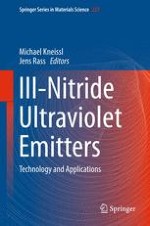2016 | OriginalPaper | Chapter
15. Application of LEDs for UV-Curing
Authors : Christian Dreyer, Franziska Mildner
Published in: III-Nitride Ultraviolet Emitters
Publisher: Springer International Publishing
Activate our intelligent search to find suitable subject content or patents.
Select sections of text to find matching patents with Artificial Intelligence. powered by
Select sections of text to find additional relevant content using AI-assisted search. powered by
